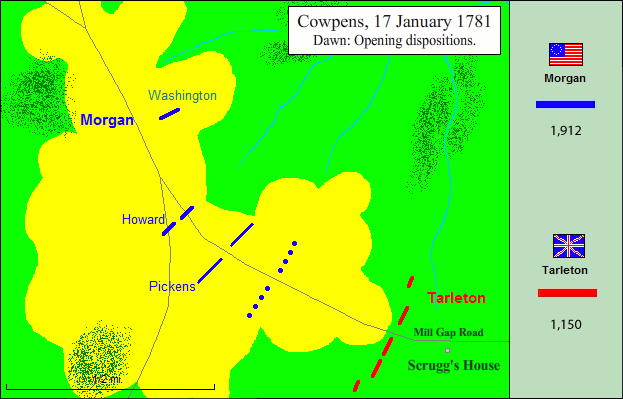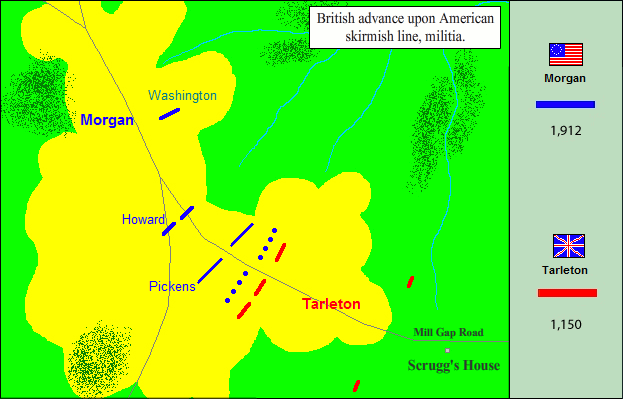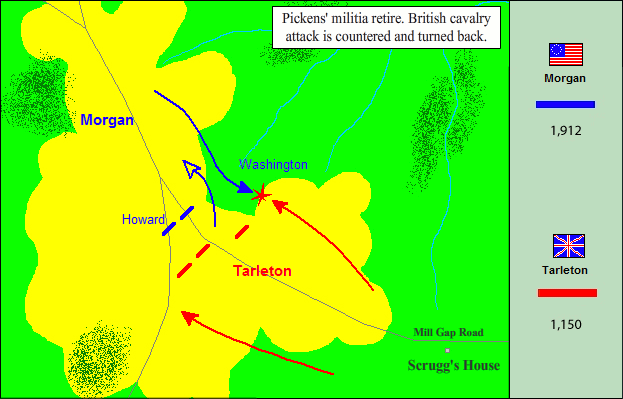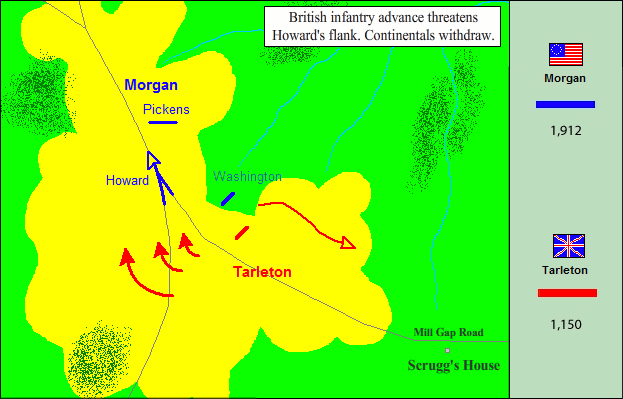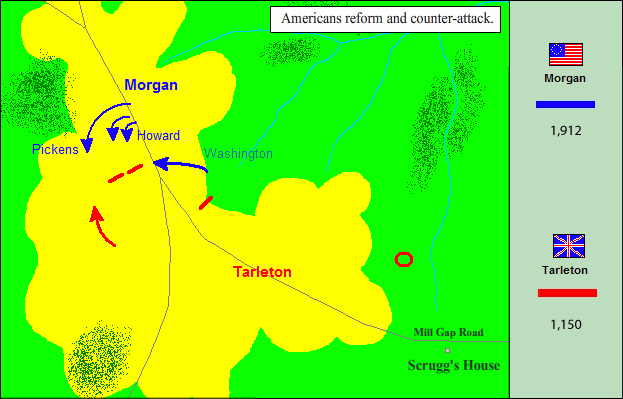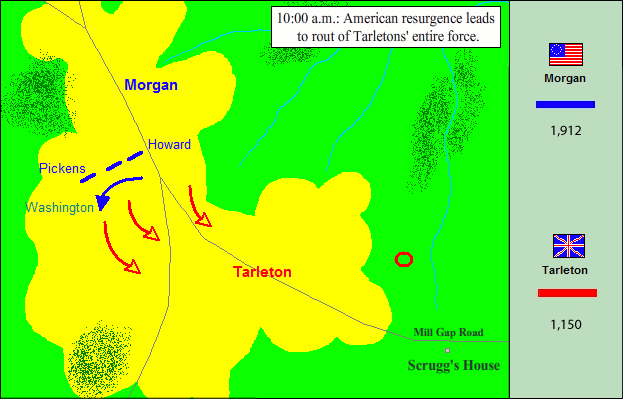Just hold your heads up, boys, give them three fires, and you will be free. Then when you return home, how the old folks will bless you and the girls will kiss you.
–Daniel Morgan
Whatever the ministry in London might do next, at King’s Mountain Britain’s cause in the south had been dealt a decided check. With his left wing crushed, Cornwallis was forced to abandon his immediate plan to push on to Hillsboro. He fell back from Charlotte in the middle of October and by the end of the month was back in South Carolina at Winnsboro, halfway between Camden and Ninety-Six. Nor did his troubles end at King’s Mountain on his left. Francis Marion continued to slash at his long and vulnerable line of supply to Charleston on his right. Another hard-riding partisan, Thomas Sumter, was making more trouble nearer to hand. On 9 November Sumter struck and scattered two hundred Regulars at Fishdam Ford on the Broad River; two weeks later he fought Tarleton’s Legion to a bloody draw at Blackstock’s Plantation in the hill country above the Tyger River. In Philadelphia, Congress, still smarting from the Camden disaster, had to be heartened by what the part-time soldiers had done at King’s Mountain and elsewhere. But perhaps the crucial fact was that they were part-time soldiers, and it was important to note that the force that crushed Ferguson had dissolved almost as quickly as it had formed. Finding a capable commander who could make something of the remnants of the southern army was Congress’ immediate problem. Congress had not chosen wisely thus far. Robert Howe’s invasion of East Florida had come to nothing in the spring of ’78, and he had been routed from Savannah soon thereafter. Benjamin Lincoln was a fighter, but he had been forced to defend a city that probably could not be held, and lost city and army both. Gates had left the wreckage of his army on his backtrail from Camden. Now Congress did what it should have done in the first place: consult the commander-in-chief. Washington was quick to name Nathanael Greene, Congress for once was quick to confirm him, and by the middle of October Greene had his orders: to ride south with all dispatch and sort out the demoralized fragments of the southern army.
This Quaker turned soldier turned quartermaster turned army commander was just thirty-eight in 1780, but he possessed a wealth of talent and experience. He was cool-headed under fire, and his combat record was first-rate. He had fought well at Trenton, Brandywine, Germantown, Monmouth, and Newport. He had made mistakes, it was true, most notably his decision to defend Fort Washington on the Hudson, but he had learned from them. He now understood the lesson that Washington embraced as an absolutely fundamental principle: that the preservation of the army was everything. The army might win tactical victories or suffer tactical defeats, but so long as it could stay in the field, the revolution would live. As Greene wrote in a rather biting letter to Thomas Jefferson, now governor of Virginia, “The Army is all that the States have to depend upon for their political existence.” On 2 December 1780 Greene arrived in Charlotte to take command and take stock. He gave his assessment of his army and its prospects with severe economy: “dismal.” It was not an exaggeration. Of the 2,300 troops on his rolls, perhaps 800 were more or less fit for duty, and these were half-starved, half-naked, barefoot. Just three days’ rations were on hand; no guns, no gear, and hardly a Continental dollar in the war chest. With Greene, it was first things first: how to feed and clothe these bodies before he could recast their spirits. Firing off letters to Congress, to the states, to anyone in civil authority who would listen, Greene managed to get a trickle of supplies in motion. One subordinate was immediately heartened to see that Greene in twenty-four hours understood the problems of supply “better than Gates had in the whole period of his command!” In just three weeks Greene was satisfied that his army was fit to take the field.
It might be argued that Greene was compelled to take the field regardless of the fitness of his troops. He could hardly let them idle away the winter in camp, and certainly not in this camp, which frankly stunk of defeat and despair. In any case, it would be difficult to feed them in the neighborhood of Charlotte, which had been fairly picked clean by the British occupation before him and now his own. Then too, the fitness of his army had been strengthened by reinforcement, small but significant. First, Daniel Morgan, a big man in buckskins, had been called out of retirement. (Congress, which had made very few wise choices in commanders since they chose Washington, had repeatedly passed Morgan over for high command.) He was old and arthritic, but there was still a good deal of fight in the “Old Wagoner.” Light-Horse Harry Lee of Virginia would come in shortly as well, and his 300 horsemen were a crack outfit. Greene’s military education thus far had been two-fold: by wide reading before the war and then by first-hand experience at Washington’s side on the battlefield. What Greene proposed next would seem to defy both those schools. The military axiom is simple: never divide your forces in the face of a superior enemy. But that is precisely what he intended. Seeing that a good measure of success in South Carolina had been achieved by the guerilla bands, Greene intended to strengthen them. Henry Lee’s Legion would ride south to the Pee Dee swamps to cooperate with Francis Marion. The partisans could not win a great victory, but they could keep Cornwallis off-balance and looking over his shoulder. In the meantime Morgan would take a small detachment–just a thousand by the time militia reached him–and march west for the country between the Pacolet and Broad rivers. From here Morgan threatened Cornwallis’ flank and particularly his supply post at Ninety-Six. Greene with the rest of the army would march southeast for Cheraw on the Pee Dee. When the Americans were in motion, Cornwallis would have to move as well. Where and how was the question. Greene, playing his cards like a riverboat gambler, had to hope that Cornwallis would in turn divide his forces, sending at least a detachment after Morgan and moving with the rest to check his advance on Cheraw. With luck, Morgan might be able to give battle on fairly even terms and cut up part of Cornwallis’ command. Of course, Cornwallis was a student of war too. He might very well concentrate his whole force against Greene at Cheraw, where the Americans would certainly be outnumbered and perhaps overwhelmed. Cornwallis was a fighter. Unlike Howe and Clinton before him, he had not been taught caution by the slaughter on Breed’s Hill. If Cornwallis could pin the ragtag American army with its back against the Pee Dee River, Greene would add the destruction of his army to the calamitous defeats suffered by Gates and Lincoln. For Cornwallis it was a consummation devoutly to be wished. But a strike at Greene in strength would expose his own chain of supply posts to the west, and the specter of Morgan gobbling up the post at Ninety-Six and then tearing eastward down the Saluda to the Congaree and beyond gave the earl pause. In the end, Cornwallis decided that his hard-riding cavalryman Tarleton and his green-jacketed legion would have to go westward to take Morgan’s column off the board. “If Morgan is anywhere within your reach,” Cornwallis wrote to Tarleton, “I wish you to push him to the utmost.” The Legion, backed by the 7th Royal Fusiliers and 71st Highlanders, set off in hot pursuit on 6 January.
The muddy roads did not slow Tarleton much, and by the 16th his prey, the Old Wagoner, was well within reach. Morgan had been falling back northward toward the fords of the Broad River, and it is likely that he would have put the river between his command and Tarleton’s pursuit if the British had not so swiftly closed with the lumbering American column. As it stood now, Morgan was still six miles from the rain-swollen river and the British just ten miles to the south. To be overtaken crossing a flooded river spelled disaster, and Morgan decided to turn danger into opportunity. He would stand and fight in a little meadow just south of Thickety Creek, known locally as Hannah’s Cowpens. In peace, it had been a rendezvous for drovers moving cattle to market. In war it seemed unpromising ground for defense: it was open country, perhaps 500 yards deep, a low hill to the south and an even lower hill immediately behind. Being open, it was well suited to cavalry. Morgan’s own cavalry was a good outfit and ably led by William Washington. (He was a second cousin to the commander-in-chief; a good portrait by Peale shows the kinship.) The rub was that the American horsemen would be outnumbered three to one when the collision came. Perhaps most dangerous for the Americans, the ground here presented nothing on which to anchor either flank. It was a prospect that might have unnerved a lesser man than Dan Morgan: before him the British were pushing ahead by a forced march while behind him in the dark rolled the floodtide of the Broad River.
Long after the battle, Morgan said that he had chosen this unlikely ground with deliberate design: if a green militiaman understood that there could be no safe retreat, Morgan believed, he would stand his ground well enough. (Tarleton’s merciless brutality may have stiffened rather than weakened his enemy’s resolve.) In any case, Morgan was not going to expect too much of the militia. He spent the entire night of the 16th making his dispositions and–just as important–explaining them carefully to his entire command. He would lay out his defense in three lines, a kind of primitive defense-in-depth. In front to the south went a screen of skirmishers; these were Georgia riflemen, steady troops and crack shots. Behind them on the low rise of the first hill would go the Carolina militia under Pickens. They would not have to bear the whole weight of the British attack, Morgan explained with simple good cheer: “Just hold your heads up, boys, give them three fires, and you will be free. Then when you return home, how the old folks will bless you and the girls will kiss you.” However a man might cherish the blessings of the old and the kisses of the girls, the idea of returning home safe and not being skewered here on a British bayonet was a reassuring thought. All a man would have to do in the morning would be deliver three volleys and then do some tall walking to the rear. The business-end of Morgan’s plan relied on the Marylanders and Delawares in the third line. They were to understand that the withdrawal of the militia in front of them was just that–withdrawal, not rout. If the Regulars came on in some disorder, the Continental Line might do some real destruction. Posting Washington’s horsemen behind the second hill as his only reserve, the Old Wagoner was as ready as he was going to be.
At dawn of 17 January Tarleton pushed ahead in hot haste and was hotly received by the Georgia riflemen. With infantry in the center and dragoons on their flanks, the British advanced smartly enough, but the Georgians tumbled riders from their saddles and dropped the light infantrymen in their tracks. They were especially sharp in picking off officers. As the Georgians fell back from tree to tree in front, the main line of the British advance closed with Pickens’ militiamen on the gentle slope of the first hill. There was the pop, pop, pop of some undisciplined fire from the Carolinians, but then the first of the promised volleys flamed out. The first volley shivered and the second staggered the oncoming British. The militiamen, figuring they had done enough for now, withdrew as per orders to the left of the American lines. The British, meanwhile, took this withdrawal to be a rout and pushed ahead in some disorder but with renewed confidence. On their right the dragoons galloped in to cut up what they took to be the fleeing farmers of Picken’s command. Both infantry and horsemen, however, got a great deal more than they bargained for. The infantry collided headlong into the steady musketry of the Continentals. Already bruised, they were now much bloodied. As for the dragoons on the right, just as they were about to swoop down on the militia, Morgan sent William Washington’s cavalry crashing down on them. There were a few moments of clanging sabers and pistols fired in one another’s faces, but the dragoons could not keep up the fight and fled.
By now Tarleton was growing desperate to exert some control over a battle that was in danger of spinning out of control. Despite their losses, his main line was pressing the attack manfully enough. Now he sent his only reserve–the 71st Highlanders–forward on his left in an attempt to turn the American right. General John Eager Howard, in command of the American line here, saw the advance of the Highlanders with proper concern; they extended well beyond his right and would soon be in his rear. His response was a textbook solution to the tactical problem: he would “refuse” his right, bending his flank back at a right angle to the main line. It was a good idea, but the men who had to execute it here were not Continentals but Virginia militia. These about-faced on orders and at least began to wheel to the left (leaving their backs exposed to an onrushing enemy). Apparently, there was a good deal of understandable confusion that threatened to unhinge the Continentals in the center, but in the end they simply withdrew steadily and in good order to the rear of the second hill. The British, however, were about to miscalculate again. Taking the withdrawal of the Virginians to be a rout, they rushed over the crest, a vengeful mob now and no longer a cohesive line of battle. Howard and Morgan were both on hand here, and both could see that the disorder was all on the British side of the field. The Virginians reformed and poured punishing volleys into the milling Highlanders. This check was doubled when Washington’s cavalry came crashing down once more, this time on the Highlanders’ right, and then redoubled when Pickens’ men returned to the fighting. They marched out from behind the hill and pitched into the British left. Now it was all the Highlanders could do to get out of the killing zone. Though they struggled on with desperate courage, very few did. Many were killed outright, more wounded, and the survivors threw down their arms and called for quarter. By ten o’clock the battle was over.
Tarleton in impotent rage called for an attack with what remained of his dragoons–perhaps forty in all at this point–but these simply refused and rode off in defeat with their seething commander. And what a defeat: 100 dead, more than 200 wounded, 800 captives in all, with most of their gear, ammunition, and supplies. Tarleton’s force had been virtually wiped out while Morgan counted his losses at 12 dead and 61 wounded. One of Tarleton’s wounded young lieutenants had no doubt about who and what was to blame for this calamity: Tarleton and his “premature, confused, and irregular” direction of the battle. Indeed, Tarleton had carried out the attack like a commander of a flying column without proper reconnaissance or even waiting for his reserve, the Highlanders, to reach the field. While this assessment is true enough, it scarcely does credit to Morgan across the way, who made his dispositions with deliberate care and who responded to the hour of emergency with cool-headed skill. He got yeoman service from his militia because he knew them well, understanding their strengths and their limits, and his Continentals stood their ground like the Regulars they were. The next day Morgan gathered up his victorious command, his dispirited prisoners, and his spoils of war and started the whole lot north toward the fords of the Catawba and Ramsour’s Mill beyond. It was the last time the Old Wagoner would “crack the whip.” Weighed down with age and arthritis, he would soon leave the army for good this time. When word of Morgan’s victory came the next day to Cornwallis, he marched at once to catch him, expecting to find and destroy him in the neighborhood of Ninety-Six. His pursuing column spent one driving day’s march in precisely the wrong direction, however, and before Cornwallis even neared that place, Morgan was long gone and on the road to Salisbury and an eventual juncture with Nathanael Greene. It was for Morgan a sharp little insult to add to the great injury he had done the British cause at Hannah’s Cowpens.

